
Wine Culture and Information since 2002 - Volume 22
 Wine Culture and Information since 2002 - Volume 22 |
|
Syrah - ShirazTwo names for the same grape, capable of giving great wines, longeval, complex, dense and rich in personality, two names mainly bound to two wine areas having two different enological styles |
|
Syrah or Shiraz - name with which this grape is known in Australia and South Africa - belongs to the numerous group of the so called “international” grapes and today it is virtually present in every wine country of the world. Thanks to its wide spreading and notoriety, every wine lover as he or she hears talking about Syrah or Shiraz, this brings up to his or her imagination two specific places of the world: Rhône Valley in France and Australia. Syrah is found in other wine country of the world as well - such as California, Italy and South Africa - however the reference areas of this grape are still considered France and Australia, each one of them being identifiable for its particular style. Of course, of the two countries, the one having a longer tradition is the Rhône Valley, whereas in Australia Syrah - or Shiraz, as it is commonly known in the land of kangaroos - has a history shorter than two centuries. Syrah is considered one of the most noble grapes, a fact which is clearly confirmed by the best wines produced with this grape. The origin of Syrah is pretty uncertain, however the most recurrent hypothesis support the idea it is from the Middle East. Whether its origins are still uncertain, we can however be certain that Syrah was already cultivated and used for the production of wines in the Rhône Valley since Roman times. In the Rhône Valley are still produced extraordinary wines with Syrah, considered as indisputable reference points for worldwide enology. Names of famous areas in the Rhône Valley such as Hermitage, Crozes-Hermitage, Côte-Rôtie and Cornas, bring up the image of excellent wines in every wine lover. Syrah is also known for its typical aroma of black pepper, a characteristic that in this grape - when cultivated with quality standards and in particular areas or climatic conditions - is so evident which is practically impossible not to notice among its rich quantity of aromas.
The history of Syrah in Australia is more recent and it seems it was introduced in this country by James Busby in 1837 importing some plants of this vine from Montpellier (France). In the beginning the grape was known in Australia with the name Syrah, but it soon became Scyras and then changed into the current Shiraz. With the same name the grape is also known in South Africa. The spreading of Syrah in Australia was pretty rapid and it quickly become the most cultivated vine in New South Wales. Today Shiraz is the most common red berried grape in Australia and in the course of the years, the producers of this country have been successful in creating a pretty personal style which is often more famous than the Syrah produced in the Rhône Valley, the homeland of this grape. The success of Australia Shiraz is such that today most of the wine lovers call this grape with the Australian term instead of the original Syrah. The differences between French Syrah and Australian Shiraz are not only determined - of course - by the environmental and climatic diversities of the two places - essential factors however contributing to the personality of a wine - but also to the wine making styles adopted in the two countries. In France, and in particular in the Rhône Valley, Syrah is in most of the cases vinified as a varietal wine, rarely adding Viognier, whereas in Australia this grape, besides being vinified as varietal, is often blended to Cabernet Sauvignon, another famous international grape. It should however be observed that in southern France - and in particular in the Languedoc-Roussillon, Syrah is usually blended to Grenache Noir, Mourvèdre and Cinsaut. When it is vinified as a varietal wine, Syrah from the Rhône Valley tends to develop aromas which directly remind black pepper - a characteristic which usually identifies wines produced in this area - and spices in general, whereas in Australia they usually have aromas and flavors of ripe fruit and jam as well as chocolate. Despite ampelographers identify Syrah in only one variety, many viticulturists in the Rhône Valley support the hypothesis of the existence of two distinct types, capable of producing wines with different organoleptic qualities. They believe Syrah can be classified in two varieties depending on the size of berries: Petite Syrah, with small berries and considered the best one, and Grosse Syrah, with larger berries and a lesser concentration of phenolic substances. It should be however observed this Petite Syrah, as well as Syrah, has no varietal connection with the Petite Sirah known in North and South America. Syrah is a grape which easily tends to overproduction and in this case, just like Merlot, it makes wines with pale colors and pretty neutral flavors. The production of quality wines with Syrah grape therefore requires very strict cultural standards and, in particular, low yields per hectare. Syrah is a relatively late ripening grape, it develops in pretty compact bunches with oblong dark colored berries. It needs a warm climate in order to reach full ripeness, however even in cooler climates, in which grapes do not reach full ripeness, it can produce wines with interesting aromas. Syrah tends to rapidly lose its best qualities when the yields are pretty high and in case it was left in the vine too long, it rapidly lose acidity and aromatic qualities, in particular its typical black peppery aroma. The berries of this grape contain high quantities of pigments and polyphenolic substances - a quality easily recognizable in the color and transparency of its wines - which makes Syrah very suited for the production of wines to be aged in cask for long times. Wines produced with Syrah are pretty longeval and the aging in bottle can also go from a period of 4 years for low quality wines, to 15-18 years for high quality wines.
|
||||||||
|
Because of the high quantity of pigments, the color of wines produced with Syrah grape is usually pretty dark and intense, with a very reduced transparency. This is true for wines produced with grapes coming from very low yields harvests, whereas when yields are excessive, the color in Syrah wines are pretty pale and the transparency is moderate, just like Merlot. In Syrah produced with quality standards, transparency can even be absent, almost impenetrable to light. Syrah is a pretty longeval wine and, in best cases, it can also stand to more than 15 years. During its youth Syrah will show evident purple nuances, a characteristic which is frequently found after one year of aging when the wine can be considered as “ready”. The evolution is similar to other red wines produced with grapes rich in pigments and even when it can be considered “mature”, Syrah will show an intense and deep ruby red color with nuances of garnet red.
|
|
The aromatic composition of Syrah is pretty rich and, more than other grapes, it is strongly affected by environmental, cultural and climatic conditions. The first distinction should be made for Syrah produced in Europe - and in particular in France - and Syrah produced in the so called “New World”. Syrah wines produced in Europe are usually characterized by more or less accentuated aromas of black pepper, a quality which is attenuated in wines from the New World in which it is common the aroma of ripe fruit and jams. Another characteristic of Syrah is represented by the “wood” factor and by the aging in cask. Syrah wines produced with ripe grapes the impact of typical toasted aromas of wood will be more evident than in those produced with not fully ripe grapes. When it is produced in cool climate areas or with grapes not fully ripe, Syrah develops aromas of black currant, cherry, blueberry, raspberry, violet, mint and white pepper, and very frequently the aroma of green olive as well. Wines produced in warm climate areas or with ripe grapes, develop aromas of black berried fruits, such as blackberry, plum, black currant, black cherry and violet as well as its typical aromas of black pepper, licorice and frequently hints of smoky. To these aromas are also included the ones of the same fruit jams. With time Syrah - a wine which has interesting potentialities of aging in bottle and of organoleptic evolution - develop pretty complex aromas in which will be perceived clear jammy aromas that will then evolve as game, leather, coffee, burnt rubber, caramelized sugar, raisin and tar.
|
||||
|
Even for taste, just like for aromas, it is necessary to make distinctions among Syrah wines produced in the Rhône Valley, Syrah made in Europe and those produced in Australia and in the New World. The French style of the Rhône Valley favors the production of elegant and refined Syrah, robust, with round flavors and less tannic. In Australia is favored a denser style, full bodied, concentrated and rich. In the rest of Europe can be found styles that could be defined as in-between, inspired to one or the other category. Syrah is a grape with a moderate quantity of acid, however in certain cases it can be clearly perceivable. The most common production style favors alcoholic percentages from moderate to high, even 14-15%. Its content in polyphenols is pretty high and therefore astringency will be a predominant factor in wines produced with this grape. Despite the aging in cask will contribute to smooth the astringency of Syrah, this organoleptic quality will however be a primary characteristic for this grape.
|
|
The northern part of the Rhône Valley, in France, remains one of the indisputable reference points for the production of wines made with Syrah grape. The best examples of varietal Syrah, no matter a small percentage of Viognier is allowed, are the ones produced with the appellations Hermitage, Côte-Rôtie, Cornas, St-Joseph and Crozes-Hermitage. Wines produced in these areas have pretty strong fruit aromas, a good acidity, dry and are characterized by the typical aroma of black pepper as well as an appreciable mineral taste. Hermitage has a deep color and intense fruit aromas, in particular black currant, full body and evident astringency. Côte-Rôtie generally has a paler color, more complex aromas which can also remind smoky and a less tannic flavor. Quality Cornas - very rare to find - have deep colors, a strong aroma of black pepper and a tannic flavors. Crozes-Hermitage and St-Joseph wines represent lighter versions but however interesting. Syrah is also common in the southern part of Rhône Valley and it is used in Châteauneuf-du-Pape wines and in other wines of this area, and as frequently happens in wines produced in south France, it is blended with other grapes. In Italy Syrah is pretty common and good results have been produced both in Tuscany and Sicily. In Switzerland it is interesting the Syrah produced in the Valais area and in Spain the one produced in the Toledo area. In the so called “New World”, Australia is the most renowned representative for wines produced with Syrah, or Shiraz, as it is known in this country. Here the style is denser, richer and more concentrated as opposed to the styles made in Europe. Examples of reference Syrah wines produced in Australia mainly come from the southern part and in particular from the areas of McLaren Vale, Barossa and Coonawarra. The styles of these three areas are pretty distinctive: Syrah wines from McLaren Vale are very dense and concentrated; the ones from Barossa are pretty similar although adding a touch of elegance to concentration; those from Coonawarra, because of a cooler climate, develop aromas of mint and black pepper. Other interesting areas in Australia in which it is produced Shiraz are the Victoria (Yarra Valley, Grampians and Pyrenees), New South Wales (Hunter Valley, Mudgee) as well as some areas in Western Australia. In California the Syrah is not very common, however it is catching the attention of many producers. The most interesting example of California are from the coolest areas of Edna, Santa Ynez, Santa Maria Valleys, Carneros and Mendocino. Other areas in which are being produced wines with Syrah grape include South Africa - here known as Shiraz - Washington state, Chile, Argentina and New Zealand.
|
Wines of the Month |
|
|
|
Score legend Prices are to be considered as indicative. Prices may vary according to the country or the shop where wines are bought |
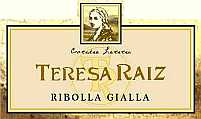
|
|
COF Ribolla Gialla 2003 |
|
| Teresa Raiz (Italy) | |
| Grapes: Ribolla Gialla | |
| Price: € 8,94 | Score: |
| The wine shows a brilliant greenish yellow color and nuances of greenish yellow, very transparent. The nose reveals intense, clean, pleasing and refined aromas which start with hints of pineapple and pear followed by aromas of banana, broom, peach, plum, apple and hints of mineral and elder. In the mouth has good correspondence to the nose, a crisp attack and however balanced by alcohol, good body, intense flavors, agreeable. The finish is persistent with flavors of peach, plum and pineapple. This wine ages for at least 6 months in steel tanks and for at least one month in bottle. | |
| Food Match: Broiled fish, Fried fish, Pasta and risotto with fish and crustaceans | |
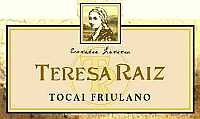
|
|
COF Tocai Friulano 2003 |
|
| Teresa Raiz (Italy) | |
| Grapes: Tocai Friulano | |
| Price: € 8,38 | Score: |
| This wine shows a brilliant greenish yellow color and nuances of greenish yellow, very transparent. The nose denotes intense, clean, pleasing and refined aromas which start with hints of pineapple, pear and hawthorn followed by aromas of banana, broom, almond, apple, peach, plum and hints of mineral. In the mouth has good correspondence to the nose, a crisp attack and however balanced by alcohol, good body, intense flavors, agreeable. The finish is persistent with flavors of pear, pineapple and peach. This wine ages for at least 6 months in steel tanks and for at least one month in bottle. | |
| Food Match: Mushroom and vegetables soups, Pasta and risotto with fish and vegetables, Sauteed meat | |
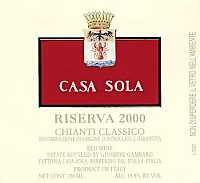
|
|
Chianti Classico Casa Sola Riserva 2000 |
|
| Fattoria Casa Sola (Italy) | |
| Grapes: Sangiovese (90%), Cabernet Sauvignon (7%), Merlot (3%) | |
| Price: € 18,00 | Score: |
| This Chianti shows a brilliant ruby red color and nuances of garnet red, moderate transparency. The nose reveals intense, clean, pleasing and refined aromas that start with hints of black cherry, violet and raspberry followed by aromas of plum, blueberry, licorice, vanilla and menthol. In the mouth has good correspondence to the nose, a slightly tannic attack and however balanced, good body, intense flavors, good tannins, agreeable. The finish is persistent with flavors of plum, black cherry and blueberry. This Chianti ages for 24 months in cask. | |
| Food Match: Roasted meat, Stewed meat, Broiled meat, Hard cheese | |
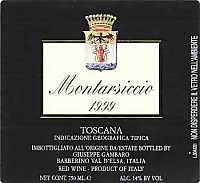
|
|
Montarsiccio 1999 |
|
| Fattoria Casa Sola (Italy) | |
| Grapes: Cabernet Sauvignon (60%), Sangiovese (30%), Merlot (10%) | |
| Price: € 20,00 | Score: |
| The wine shows a brilliant ruby red color and nuances of garnet red, moderate transparency. The nose reveals intense, clean, pleasing and refined aromas which start with hints of black cherry, plum and violet followed by aromas of blueberry, blackberry, licorice, tobacco and vanilla. In the mouth has good correspondence to the nose, a slightly tannic attack and pleasing roundness, however balanced by alcohol, good body, intense flavors, good tannins, agreeable. The finish is persistent with flavors of black cherry, plum and blueberry. Montarsiccio ages for 24 months in barrique. | |
| Food Match: Roasted meat, Stewed meat with mushrooms, Hard cheese | |
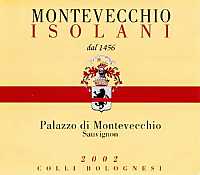
|
|
Colli Bolognesi Sauvignon Palazzo di Montevecchio 2002 |
|
| Montevecchio Isolani (Italy) | |
| Grapes: Sauvignon Blanc | |
| Price: € 7,10 | Score: |
| This wine shows an intense greenish yellow color and nuances of greenish yellow, very transparent. The nose denotes intense, clean, pleasing and refined aromas which start with hints of toasted wood, peach and broom followed by aromas of pineapple, hawthorn, pear, elder, plum and grapefruit. In the mouth has good correspondence to the nose, a crisp attack and pleasing roundness, however balanced, good body, intense flavors. The finish is persistent with flavors of peach, pineapple and plum. This wine ages for 6 months in barrique and for at least 6 months in bottle. | |
| Food Match: Mushroom and vegetables soups, Pasta and risotto with fish and crustaceans, Broiled fish | |
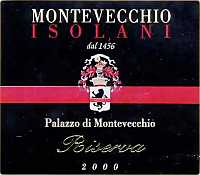
|
|
Colli Bolognesi Cabernet Sauvignon Riserva Palazzo di Montevecchio 2000 |
|
| Montevecchio Isolani (Italy) | |
| Grapes: Cabernet Sauvignon | |
| Price: € 12,00 | Score: |
| This wine shows an intense ruby red color and nuances of garnet red, little transparency. The nose reveals intense, clean, pleasing and refined aromas which start with hints of black cherry, plum and vanilla followed by aromas of black currant, toasted, cinchona, violet, tobacco and licorice. In the mouth has good correspondence to the nose, a slightly tannic attack and pleasing roundness, however balanced by alcohol, good body, intense flavors, good tannins. The finish is persistent with flavors of plum, black cherry and black currant. This wine ages for three years in barrique and for 6 months in bottle. | |
| Food Match: Roasted meat, Stewed and braised meat with mushrooms, Hard cheese | |
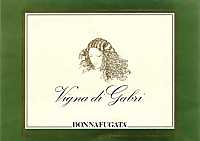
|
|
Contessa Entellina Vigna di Gabri 2003 |
|
| Donnafugata (Italy) | |
| Grapes: Ansonica (Inzolia) | |
| Price: € 9,80 | Score: |
| The wine shows a brilliant straw yellow color and nuances of greenish yellow, very transparent. The nose denotes intense, clean, pleasing and refined aromas which start with hints of plum, pear and vanilla followed by aromas of hawthorn, apple, grapefruit, banana and hints of butter, praline and almond. In the mouth has good correspondence to the nose, a crisp attack and pleasing roundness, good body, intense flavors. The finish is persistent with flavors of banana, plum and almond. A small part of this wine ferments in barrique and ages for 4 months in bottle. | |
| Food Match: Stuffed pasta, Roasted fish, Mushrooms and fish soups, Pasta with vegetables, Sauteed white meat | |
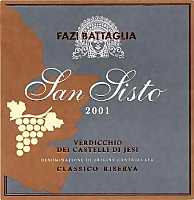
|
|
Verdicchio dei Castelli di Jesi Classico Riserva San Sisto 2001 |
|
| Fazi Battaglia (Italy) | |
| Grapes: Verdicchio | |
| Price: € 15,00 | Score: |
| This Verdicchio shows a pale golden yellow color and nuances of straw yellow, very transparent. The nose reveals good personality with intense, clean, pleasing, refined and elegant aromas which start with hints of hawthorn, vanilla and apple followed by aromas of pineapple, mango, pear, plum, almond and hints of butter and mineral. In the mouth has good correspondence to the nose, a crisp attack with pleasing roundness, however well balanced by alcohol, good body, intense flavors, agreeable. The finish is persistent with flavors of apple, plum, pear and almond. A well made wine. San Sisto ages for 12 months in barrique followed by 12 months of aging in bottle. | |
| Food Match: Mushrooms and fish soups, Pasta with fish, Roasted fish, Roasted white meat | |

|
|
Arkezia Muffo di San Sisto 2001 |
|
| Fazi Battaglia (Italy) | |
| Grapes: Verdicchio | |
| Price: € 26,00 - 500ml | Score: |
| This wine shows a pale golden yellow color and nuances of golden yellow, very transparent. The nose reveals intense, clean, pleasing, refined and elegant aromas which start with elegant hints of dried apricot, peach jam and vanilla followed by good aromas of chamomile, honey, ripe banana, candied fruit, quince jam, litchi, orange marmalade, hazelnut and hints of enamel. In the mouth has very good correspondence to the nose, a sweet and smooth attack, however well balanced, good body, intense flavors, good crispness, agreeable. The finish is persistent with long flavors of dried apricot, peach jam, honey and candied fruit. A very well made wine. Arkezia is produced with late harvested grapes affected by Botrytis Cinerea (Noble Rot), ages for 14-16 months in barrique followed by 6 months of aging in bottle. | |
| Food Match: Hard and piquant cheese, Dried fruit tarts | |
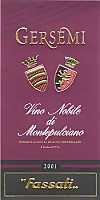
|
|
Vino Nobile di Montepulciano Gersemi 2001 |
|
| Fassati (Italy) | |
| Grapes: Sangiovese (90%), Merlot, Cabernet Sauvignon (10%) | |
| Price: € 20,00 | Score: |
| The wine shows an intense ruby red color and nuances of garnet red, little transparency. The nose reveals intense, clean, pleasing and refined aromas that start with hints of black cherry, plum and violet followed by aromas of blueberry, licorice, cinnamon, vanilla, menthol and hints of cocoa. In the mouth has good correspondence to the nose, a slightly tannic attack and however balanced by alcohol, good body, intense flavors, good tannins, agreeable. The finish is persistent with flavors of plum and black cherry. This wine ages for two years in cask followed by 10 months of aging in bottle. | |
| Food Match: Roasted meat, Braised and stewed meat, Hard cheese | |
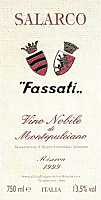
|
|
Vino Nobile di Montepulciano Riserva Salarco 1999 |
|
| Fassati (Italy) | |
| Grapes: Sangiovese | |
| Price: € 25,00 | Score: |
| This wine shows an intense ruby red color and nuances of garnet red, little transparency. The nose reveals intense, clean, pleasing and refined aromas which start with hints of plum jam and dried violet followed by aromas of black cherry, blueberry jam, carob, licorice, tobacco, vanilla and mace. In the mouth has good correspondence to the nose, a slightly tannic attack and pleasing roundness, however well balanced by alcohol, full body, intense flavors, good tannins, agreeable. The finish is persistent with flavors of plum jam and black cherry. A well made wine. This reserve ages for 3 years in cask followed by 10 months of aging in bottle. | |
| Food Match: Game, Roasted meat, Braised and stewed meat, Hard cheese | |
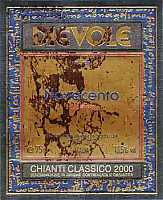
|
|
Chianti Classico Riserva Novecento 2000 |
|
| Dievole (Italy) | |
| Grapes: Sangiovese, Canaiolo Nero, Colorino, Malvasia Nera | |
| Price: € 27,00 | Score: |
| This Chianti shows a deep ruby red color and nuances of garnet red, little transparency. The nose reveals intense, clean, pleasing, refined and elegant aromas which start with hints of black cherry, plum and violet followed by good aromas of blueberry, vanilla, licorice, tobacco, cocoa, cinnamon, eucalyptus and hints of lavender and black pepper. In the mouth has good correspondence to the nose, a slightly tannic attack and pleasing roundness, however well balanced by alcohol, full body, intense flavors, good tannins, agreeable. The finish is persistent with flavors of black cherry, plum and blueberry. A very well made wine. Chianti Novecento ages in barrique for 18 months and for 6 months in bottle. | |
| Food Match: Game, Roasted meat, Braised and stewed meat, Hard cheese | |
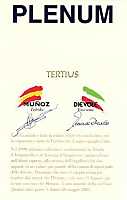
|
|
Plenum Tertius 1999 |
|
| Dievole (Italy) Muñoz (Spain) | |
| Grapes: Sangiovese (50%), Tempranillo (50%) | |
| Price: € 29,00 | Score: |
| This wine shows an intense ruby red color and nuances of garnet red, little transparency. The nose reveals good personality with intense, clean, pleasing, refined and elegant aromas which start with hints of black cherry, violet, plum and vanilla followed by aromas of blueberry, blackberry, licorice, tobacco, earthy, eucalyptus, chocolate and cinnamon. In the mouth has good correspondence to the nose, a slightly tannic attack and however well balanced by alcohol, full body, intense flavors, good tannins, agreeable. The finish is very persistent with flavors of black cherry, plum, blackberry and blueberry. A very well made wine. Plenum Tertius ages for 6 months in bottle. | |
| Food Match: Game, Braised and stewed meat, Roasted meat, Hard cheese | |
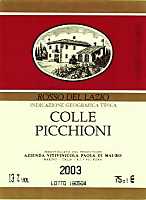
|
|
Colle Picchioni Rosso 2003 |
|
| Colle Picchioni (Italy) | |
| Grapes: Merlot, Sangiovese, Cabernet Sauvignon | |
| Price: € 9,30 | Score: |
| The wine shows an intense ruby red color and nuances of ruby red, moderate transparency. The nose denotes intense, clean and pleasing aromas which start with hints of black cherry, blueberry and plum followed by aromas of blackberry, raspberry, licorice and hints of bell pepper. In the mouth has good correspondence to the nose, a slightly tannic attack and however balanced, good body, intense flavors, good tannins. The finish is persistent with flavors of black cherry, plum and blueberry. This wine ages in steel tanks after a short period of aging in cask. | |
| Food Match: Sauteed meat, Broiled meat and barbecue, Stuffed pasta | |
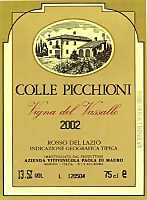
|
|
Vigna del Vassallo 2002 |
|
| Colle Picchioni (Italy) | |
| Grapes: Merlot, Cabernet Sauvignon, Cabernet Franc | |
| Price: € 21,50 | Score: |
| This wine shows a brilliant ruby red color and nuances of ruby red, moderate transparency. The nose reveals intense, clean, pleasing and refined aromas which start with hints of black cherry and blueberry followed by aromas of black currant, dried violet, plum, cocoa, licorice, tobacco and vanilla. In the mouth has good correspondence to the nose, a slightly tannic attack and however well balanced by alcohol, good body, intense flavors, good tannins. The finish is persistent with flavors of plum and black cherry. A well made wine. Vigna del Vassallo ages in barrique for about 18 months. | |
| Food Match: Roasted meat, Broiled meat and barbecue, Hard cheese | |
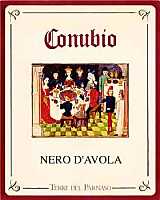
|
|
Conubio 2002 |
|
| Terre del Parnaso (Italy) | |
| Grapes: Nero d'Avola | |
| Price: € 6,00 | Score: |
| This wine shows an intense ruby red color and nuances of ruby red, moderate transparency. The nose denotes intense, clean, pleasing and refined aromas that start with hints of black cherry, raspberry and blueberry followed by aromas of blackberry, plum, black currant and licorice. In the mouth has good correspondence to the nose, a slightly tannic attack and however balanced, good body, intense flavors, good tannins. The finish is persistent with flavors of plum, blueberry and black cherry. Conubio ages for six months in steel tanks. | |
| Food Match: Sauteed meat with mushrooms, Broiled meat and barbecue, Hard cheese | |
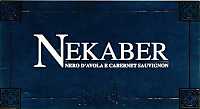
|
|
Nekaber 2002 |
|
| Terre del Parnaso (Italy) | |
| Grapes: Nero d'Avola, Cabernet Sauvignon | |
| Price: € 9,00 | Score: |
| This wine shows a brilliant ruby red color and nuances of ruby red, moderate transparency. The nose reveals intense, clean, pleasing and refined aromas which start with hints of black cherry, plum and violet followed by aromas of blueberry, licorice, tobacco, cinnamon and vanilla. In the mouth has good correspondence to the nose, a slightly tannic attack and however balanced, good body, intense flavors, good tannins. The finish is persistent with flavors of plum and black cherry. Nekaber ages for 8 months in barrique and for 6 months in bottle. | |
| Food Match: Stewed and braised meat, Roasted meat, Broiled meat and barbecue, Hard cheese | |
|
||||||||
|
DiWineTaste Polls
|
| |||||||
Privacy Policy | |||||||


| Copyright © 2002-2024 Antonello Biancalana, DiWineTaste - All rights reserved |
| All rights reserved under international copyright conventions. No part of this publication and of this WEB site may be
reproduced or utilized in any form or by any means, electronic or mechanical, without permission in writing from DiWineTaste. |